A Lens Antenna with Reconfigurable Beams for mmWave Wind Profile Radar
Abstract
:1. Introduction
2. Lens Antenna Design
2.1. Corrugated Horn Antennas
2.2. Dielectric Lens
2.3. SIW (Substrate Integrated Waveguide)-to-Waveguide Transition
3. Experimental Demonstration
4. Conclusions
Author Contributions
Funding
Institutional Review Board Statement
Informed Consent Statement
Data Availability Statement
Conflicts of Interest
References
- Edenhoffer, O. Climate Change 2014: Mitigation of Climate Change; Cambridge University Press: Cambridge, UK, 2015. [Google Scholar]
- Frehlich, R.; Kelley, N. Measurements of Wind and Turbulence Profiles with Scanning Doppler Lidar for Wind Energy Applications. IEEE J. Sel. Top. Appl. Earth Observ. Remote Sens. 2008, 1, 42–47. [Google Scholar] [CrossRef]
- Liu, Y.; Li, S.; Chan, P.W.; Chen, D. Empirical Correction Ratio and Scale Factor to Project the Extreme Wind Speed Profile for Offshore Wind Energy Exploitation. IEEE Trans. Sustain. Energy 2018, 9, 1030–1040. [Google Scholar] [CrossRef]
- Wang, H.; Gao, M.; Hu, S.; Sun, Z.; Xu, Z. Study on weather radar echo data generation based on DCGAN. IEEE Access 2019, 7, 131978–131985. [Google Scholar] [CrossRef]
- Schvartzman, D.; Curtis, C.D. Signal Processing and Radar Characteristics (SPARC) Simulator: A Flexible Dual-Polarization Weather-Radar Signal Simulation Framework Based on Preexisting Radar-Variable Data. IEEE J. Sel. Top. Appl. Earth Observ. Remote Sens. 2019, 12, 135–150. [Google Scholar] [CrossRef]
- Ivić, I. Effects of Phase Coding on Doppler Spectra in PPAR Weather Radar. IEEE Trans. Geosci. Remote Sens. 2018, 56, 2043–2065. [Google Scholar] [CrossRef]
- Lassas, M.; Mataich, M.; Siltanen, S.; Somersalo, E. Wind velocity observation with a CW Doppler radar. IEEE Trans. Geosci. Remote Sens. 2002, 40, 2427–2437. [Google Scholar] [CrossRef]
- Rundong, Q.; Changcheng, H.; Wenbin, T. Wind measurement with a wind profiling radar. J. Syst. Eng. Electron. 1991, 2, 81–88. [Google Scholar]
- Sterlyadkin, V.; Gorelik, A.; Kulikovskii, K.; Kalmykov, V.; Ermilov, D.; Khomyakov, A. Field measurements of the wind profile using millimeter Doppler radar. In Proceedings of the 2017 Progress in Electromagnetics Research Symposium (PIERS), St. Petersburg, Russia, 22–25 May 2017; pp. 897–901. [Google Scholar]
- Law, D.C.; McLaughlin, S.A.; Post, M.J.; Weber, B.J.; Welsh, D.C.; Wolfe, D.E. An electronically stabilized phased array system for shipborne atmospheric wind profiling. JAOT 2002, 19, 924–933. [Google Scholar] [CrossRef]
- Srinivasulu, P.; Yasodha, P.; Jayaraman, A.; Reddy, S.N.; Satyanarayana, S. Simplified active array L-band radar for atmospheric wind profiling: Initial results. J. Atmos. Ocean. Technol. 2011, 28, 1436–1447. [Google Scholar] [CrossRef]
- Aris, N.A.M.; Hashiguchi, H.; Yamamoto, M. Evaluation of EAR spaced antenna performance using multiple receiving antennas orientations. Radio Sci. 2020, 55, 1–14. [Google Scholar] [CrossRef]
- Venkatesh, V.; Orzel, K.; Frasier, S. Spaced-antenna aperture synthesis using an X-band active phased-array. IEEE Geosci. Remote Sens. Lett. 2021, 18, 1194–1198. [Google Scholar] [CrossRef]
- Haimov, S.; Rodi, A. Fixed-antenna pointing-angle calibration of airborne Doppler cloud radar. J. Atmos. Ocean Technol. 2013, 30, 2320–2335. [Google Scholar] [CrossRef] [Green Version]
- Battaglia, A.; Wolde, M.; D’Adderio, L.P.; Nguyen, C.; Fois, F.; Illingworth, A.; Midthassel, R. Characterization of Surface Radar Cross Sections at W-Band at Moderate Incidence Angles. IEEE Trans. Geosci. Remote Sens. 2017, 55, 3846–3859. [Google Scholar] [CrossRef]
- Srinivasulu, P.; Yasodha, P.; Kamaraj, P.; Rao, T.N.; Jayaraman, A. 1280-MHz active array radar wind profiler for lower atmosphere: System description and data validation. J. Atmos. Ocean. Technol. 2012, 29, 1445–1470. [Google Scholar] [CrossRef]
- Samson, T.K.; Kottayil, A.; Manoj, M.G.; Binoy Babu, B.; Rakesh, V.; Rebello, R.; Vasudevan, K.; Mohanan, P.; Santosh, K.R.; Mohankumar, K. Technical Aspects of 205 MHz VHF Mini Wind Profiler Radar for Tropospheric Probing. IEEE Geosci. Remote Sens. Lett. 2016, 13, 1027–1031. [Google Scholar] [CrossRef]
- Lindseth, B.; Brown, W.O.J.; Jordan, J.R.; Law, D.; Hock, T.; Cohn, S.A.; Popovic, Z. A new portable 449 MHz spaced antenna wind profiler radar. IEEE Trans. Geosci. Remote Sens. 2012, 50, 3544–3553. [Google Scholar] [CrossRef]
- Lindseth, B.; Brown, W.O.J.; Hock, T.; Cohn, S.A.; Popović, Z. Wind Profiler Radar Antenna Sidelobe Reduction. IEEE Trans. Antennas Propag. 2014, 62, 56–63. [Google Scholar] [CrossRef]
- Luo, Y.; Xu, J.; Yang, G. A Zero-mode Induced mmWave Patch Antenna with Low-Profile, Wide-Bandwidth and Large-Angle Scanning for 5G Mobile Terminals. IEEE Access 2019, 7, 177607–177615. [Google Scholar] [CrossRef]
- Kibaroglu, K.; Sayginer, M.; Rebeiz, G.M. A low-cost scalable 32-element 28 GHz phased array transceiver for 5G communication links based on a 2 × 2 beamformer flip-chip unit cell. IEEE J. Solid-State Circuits 2018, 53, 1260–1274. [Google Scholar] [CrossRef]
- Lamminen, A.E.I.; Karki, S.K.; Karttunen, A.; Kaunisto, M.; Saily, J.; Lahdes, M.; Ala-Laurinaho, J.; Viikari, V. Beam-switching dual-spherical lens antenna with low scan loss at 71–76 GHz. IEEE Antennas Wirel. Propag. Lett. 2018, 17, 1871–1875. [Google Scholar] [CrossRef]
- Liu, K.; Yang, S.; Qu, S.; Chen, C.; Chen, Y. Phased hemispherical lens antenna for 1-D wide-angle beam scanning. IEEE Trans. Antennas Propag. 2019, 67, 7617–7621. [Google Scholar] [CrossRef]
- Saleem, M.K.; Vettikaladi, H.; Alkanhal, M.A.S.; Himdi, M. Lens antenna for wide angle beam scanning at 79 GHz for automotive short range radar applications. IEEE Trans. Antennas Propag. 2017, 65, 2041–2046. [Google Scholar] [CrossRef]
- Liu, P.; Zhu, X.-W.; Zhang, Y.; Jiang, Z.H.; Wang, X.; Hong, W.; Le, T.H. A novel E-plane-focused cylindrical Luneburg lens loaded with metal grids for sidelobe level reduction. IEEE Trans. Antennas Propag. 2020, 68, 736–744. [Google Scholar] [CrossRef]
- Moreno, R.M.; Ala-Laurinaho, J.; Viikari, V. Plastic-filled dualpolarized lens antenna for beam-switching in the Ka-band. IEEE Antennas Wirel. Propag. Lett. 2019, 18, 2458–2462. [Google Scholar] [CrossRef] [Green Version]
- Nguyen, N.T.; Boriskin, A.V.; Le Coq, L.; Sauleau, R. Improvement of the scanning performance of the extended hemispherical integrated lens antenna using a double lens focusing system. IEEE Trans. Antennas Propag. 2016, 64, 3698–3702. [Google Scholar] [CrossRef]
- Lee, J. Dielectric lens shaping and coma-correction zoning, part I: Analysis. IEEE Trans. Antennas Propag. 1983, AP-31, 211–216. [Google Scholar] [CrossRef]
- Agnihotri, I.; Sharma, S.K. Design of a 3D metal printed axial corrugated horn antenna covering full Ka-band. IEEE Antennas Wirel. Propag. Lett. 2020, 19, 522–526. [Google Scholar] [CrossRef]
- Cheston, T.C. Microwave Lenses; Microwave Optics; Proc. McGill Symp.: Montreal, QC, Canada, 1959. [Google Scholar]
- Deguchi, Y.; Sakakibara, K.; Kikuma, N.; Hirayama, H. Millimeter-wave microstrip-to-waveguide transition operating over broad frequency bandwidth. In Proceedings of the 2005 IEEE MTT-S International Microwave Symposium (IMS), Long Beach, CA, USA, 12–17 June 2005; pp. 2107–2110. [Google Scholar]
- Uz Zaman, A.; Vukusic, T.; Alexanderson, M.; Kildal, P.-S. Design of a simple transition from microstrip to ridge gap waveguide suited for MMIC and antenna integration. IEEE Antennas Wirel. Propag. Lett. 2013, 12, 1558–1561. [Google Scholar] [CrossRef]
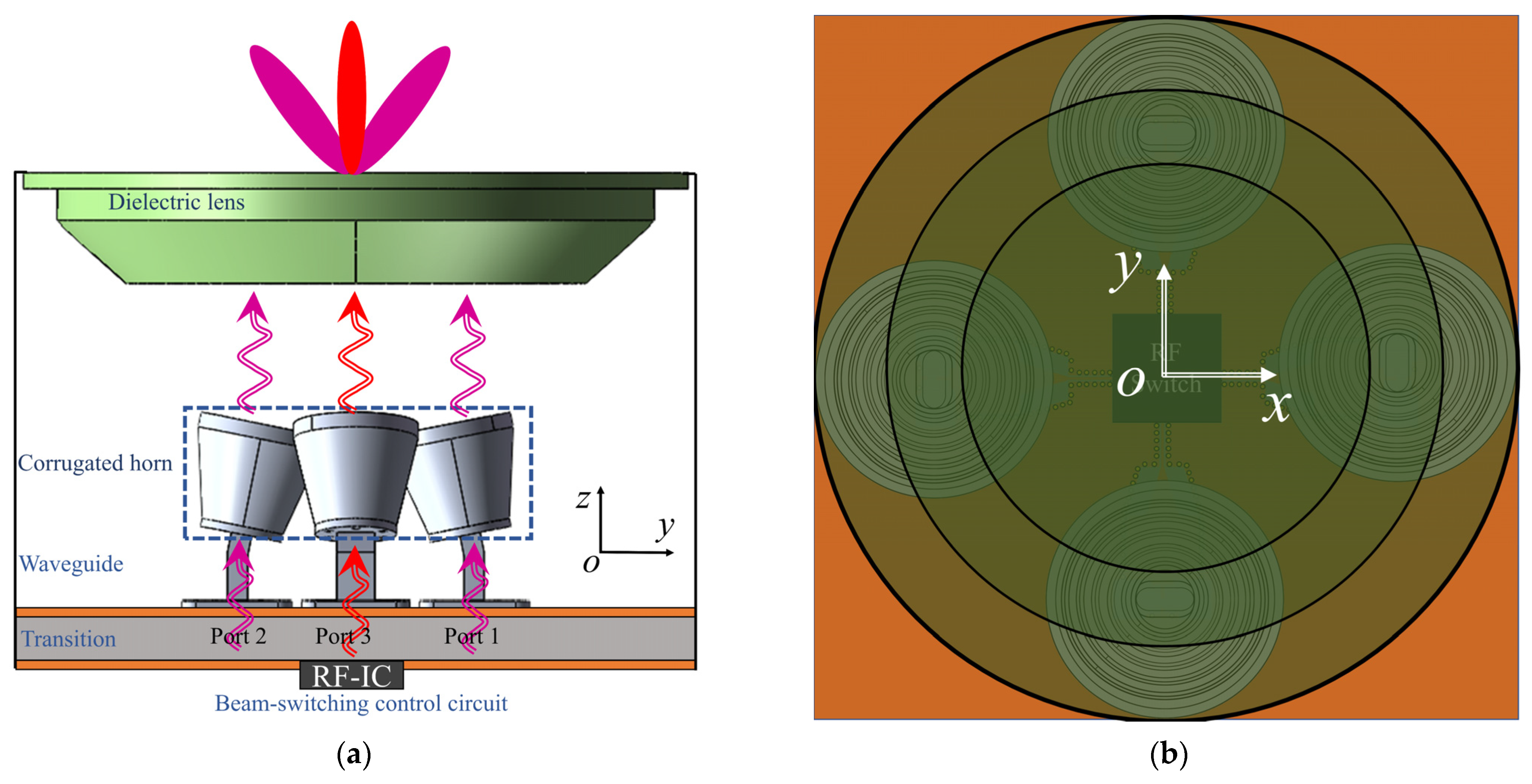
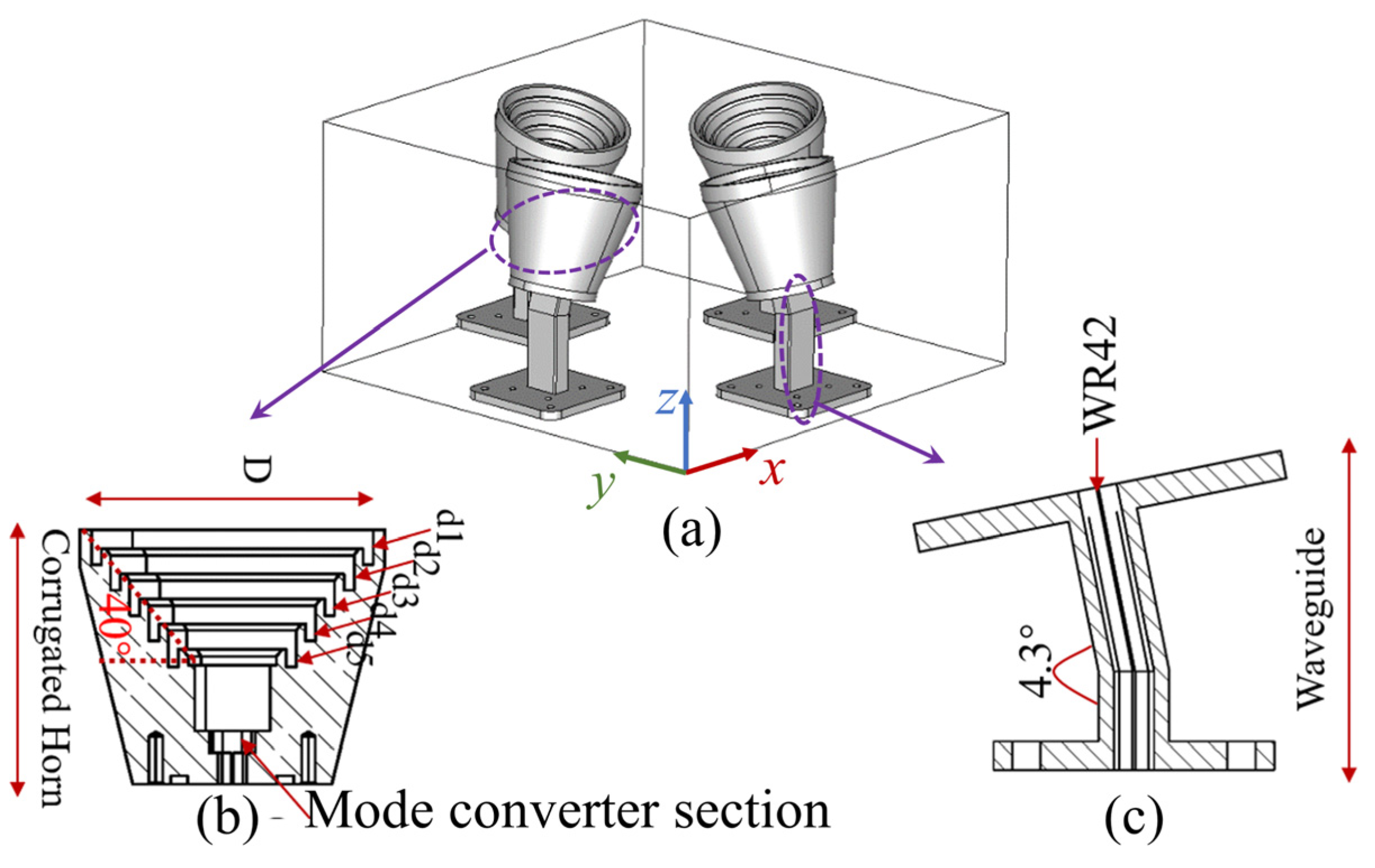
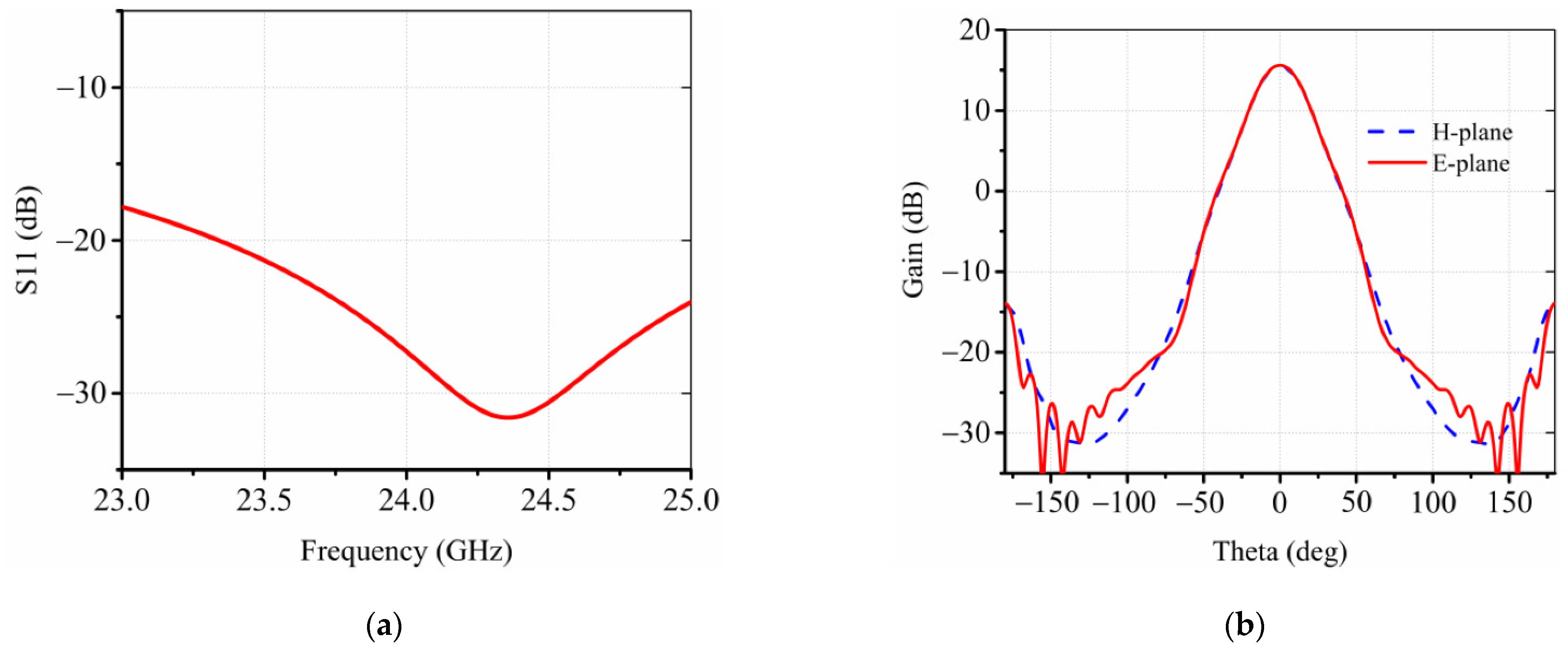
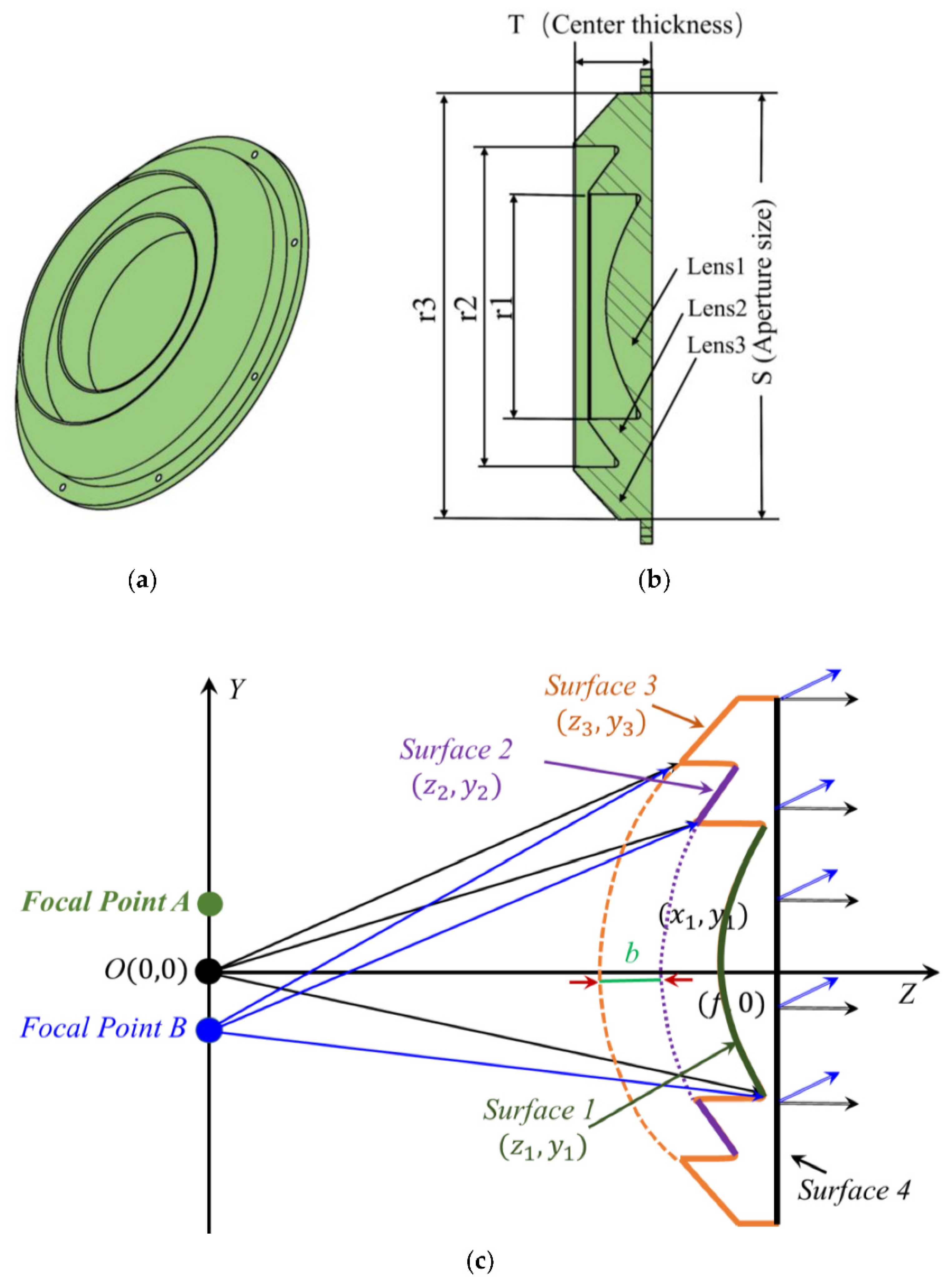


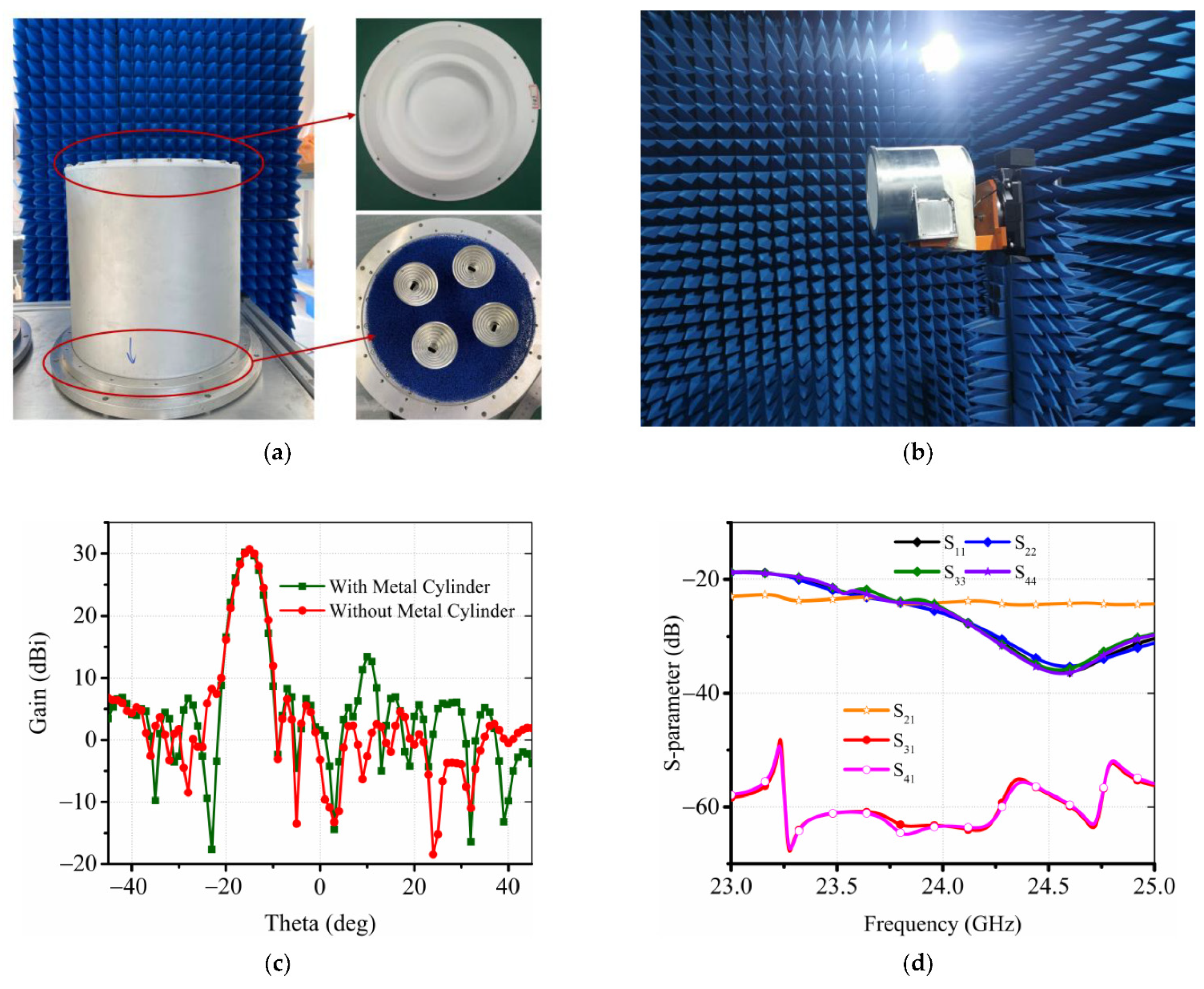

| Ref. | Freq. (GHz) | Gain (dBi) | Sidelobe (dB) | Radiation Beams | Suitable Application |
|---|---|---|---|---|---|
| [22] | 71−76 | >13.1 | <−12 | ±40° | strong signal detection |
| [23] | 27.3 | 19 | <−10 | ±45°/60° | 5G |
| [25] | 26 | 17.4 | −15.1 | \ | communication systems |
| [27] | 77 | >30 | <−15 | ±30° | strong signal detection |
| This work | 24 | >30 | <−20 | reconfigurable four beams in ±15° | weak signal detection WPR (height < 300 m) |
Publisher’s Note: MDPI stays neutral with regard to jurisdictional claims in published maps and institutional affiliations. |
© 2022 by the authors. Licensee MDPI, Basel, Switzerland. This article is an open access article distributed under the terms and conditions of the Creative Commons Attribution (CC BY) license (https://creativecommons.org/licenses/by/4.0/).
Share and Cite
Ding, Y.; Zou, Z.; Luo, Y.; Yang, G. A Lens Antenna with Reconfigurable Beams for mmWave Wind Profile Radar. Sensors 2022, 22, 3148. https://doi.org/10.3390/s22093148
Ding Y, Zou Z, Luo Y, Yang G. A Lens Antenna with Reconfigurable Beams for mmWave Wind Profile Radar. Sensors. 2022; 22(9):3148. https://doi.org/10.3390/s22093148
Chicago/Turabian StyleDing, Yafei, Ziwen Zou, Yong Luo, and Guangli Yang. 2022. "A Lens Antenna with Reconfigurable Beams for mmWave Wind Profile Radar" Sensors 22, no. 9: 3148. https://doi.org/10.3390/s22093148






